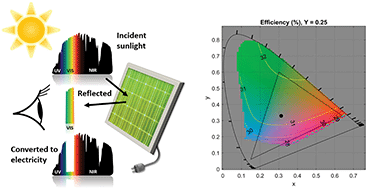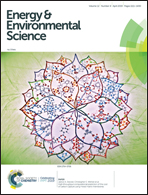Theoretical efficiency limits of ideal coloured opaque photovoltaics†
Abstract
Colour can improve the visual aesthetics of solar cells for building and product integration but constitutes an optical loss from the perspective of photovoltaic energy conversion. To quantify this compromise, we report the theoretical efficiency limits of ideal coloured opaque single-band-gap solar cells. The colours were optimized by allowing the solar cells to reflect light within two distinct wavelength bands in the visible region. Colour chromaticity and brightness were controlled by modifying the position and width of the reflection bands, while optimising the band-gap energy for each colour. We found that almost the entire sRGB colour space has an efficiency limit greater than 29%, when relative luminosity is less than 0.25. This corresponds to a relative performance loss of less than 14% compared to an ideal black solar cell. Yellow-green is the most efficient photovoltaic colour, whereas highly saturated blue, red and purple colours produce the lowest efficiencies, when compared at equal brightness. The colour-dependence is explained by the photopic sensitivity of the human eye, which peaks at yellow-green wavelengths and tails towards the blue and red ends of the visible spectrum. For most colours, except the darkest ones, the optimal band-gap energy for a theoretically ideal solar cell is between 1.115 eV and 1.135 eV, matching the value for crystalline silicon. The results clarify the link between the solar cell colour and efficiency and establish a reference point and guidelines for optimizing coloured photovoltaics.



 Please wait while we load your content...
Please wait while we load your content...